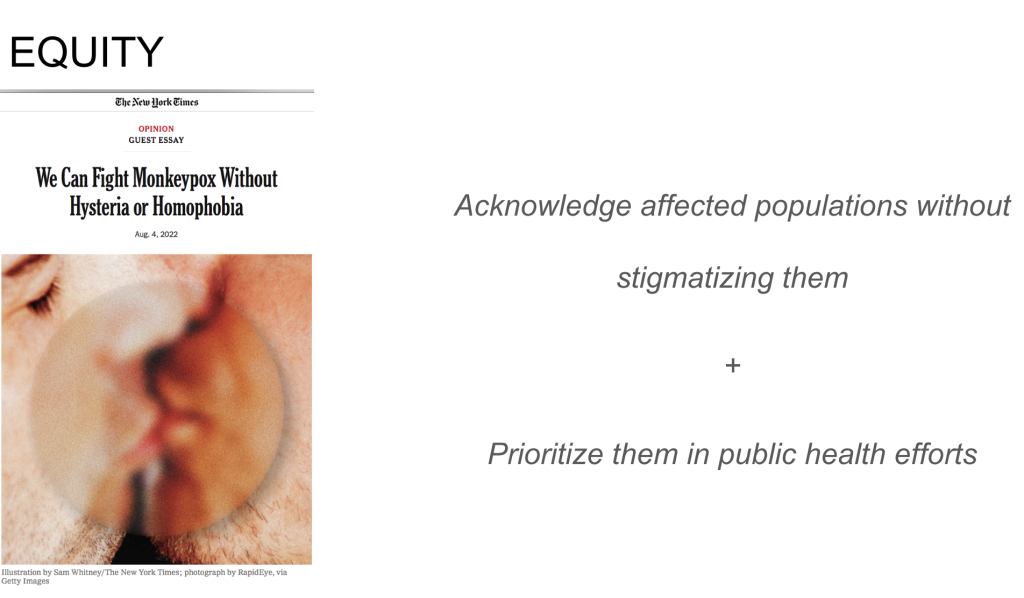So you are at Elmhurst…or MSBI… or MSH and you have a patient who is a 30 year old male with a PMH of HIV (not on ART, CD4 count unknown) presenting with a rash x 2 days. You think to yourself, oh man…I hate rashes. The rash is localized to his hands, scalp, and buttocks. He is complaining of 8/10 pain with associated fevers. Denies sore throat, nausea, vomiting, or abdominal pain.
Vitals: T 102.3, BP 122/78, HR 76, RR 18, SpO2 98.
A few questions come to mind:
- Is this monkeypox? But…what is monkeypox and what does it look like?
- What else should I consider on my differential?
- Is there a treatment? What do I do to treat it?
Before diving in, let’s set the stage.
What is monkeypox?
- Monkeypox is a pox virus closely related to smallpox. Vaccinations against smallpox also protect against monkeypox. Routine vaccination was discontinued in 1972 after the disease was eradicated in the United States. As a result, many patients do not have immunity against the virus.
- Monkeypox is not typically fatal. However, it can cause severe pain and permanent scarring of skin.
- There are two strains: West African: This strain has a more favorable prognosis with a case fatality rate <1%. & Central Basin: more lethal strain with a case fatality rate of up to 11% in unvaccinated children.
How is it transmitted?
- So far, the large majority of monkeypox cases have been identified in men who have sex with men. These patients are considered to be at a higher risk for obtaining monkeypox.
- However, the disease can also be transmitted from prolonged, close contact with live or dead persons, animal or fomites, body fluids, blood, respiratory droplets, semen, breast milk, infected skin lesions, and fomites formed by shed skin.
- “Aerosolization of the monkeypox virus can facilitate transmission, for example, if bed sheets are shaken or when performing AGPs; thus healthcare workers are at risk of contracting the virus if they are not wearing appropriate PPE.”
- People can spread monkeypox from the time symptoms start until all symptoms have resolved, including full healing of the rash with formation of a fresh layer of skin.
- Preliminary data from a small number of cases found that the chance of spreading monkeypox to a household member, not through sex, is less than 1%. By comparison, the chance of spreading SARS-CoV-2 within the home appears to be closer to 40%.
What are the symptoms?
Incubation: 3-17 days. During this time, patients are asymptomatic.
Prodrome: In classic cases of monkeypox, patients have a ~2 day of prodrome fever, malaise, myalgias, and/or headaches. 90% of patients develop lymphadenopathy.
Exanthem: The typical rash starts as maculopapular lesions 2-5 mm in diameter. The lesion progresses through four stages—macular papular → vesicular → umbilicated and pustular → before ulcerating and then scabbing over. You can also see painless anogenital lesions — often without a prodrome. These can be painful until the healing phase when they become itchy
Recovery: The illness typically lasts 2-4 weeks
If you think the diagnosis is monkeypox, here are the workflows:
So for monkeypox – what do I do next?
- While there is no treatment approved specifically for monkeypox, antivirals developed for use in patients with smallpox may prove beneficial against monkeypox, and treatment is often based on severity of illness and symptoms.
- The smallpox vaccine, which features an attenuated (weakened) form of live virus that cannot replicate, can be given to high risk individuals.
What are other lesions that look like monkeypox that should be on my differential?
| Painful Genital ulcer? Herpes – vesicular lesions, with localized or regional pain, tingling, and burning Chancroid – very painful ulcers with friable base covered with yellow-gray necrotic exudates Herpes Chancre | Painless genital ulcer? Syphilis: Primary syphilis – painless chancre; secondary syphilis – generalized maculopapular rash + lymphadenopathy and constitutional symptoms LGV: painless primary chancre Syphilis: LGV: |
Ddx of other rashes that may look like monkeypox…
| Smallpox – Lesions first appear in the throat or mouth, then on the face, or on the upper arms, changing slowly, scabbing over after 9 to 15 days. | Chickenpox – Lesions first appear on the face or trunk, rapidly crusting over within 24 hours. | Measles – maculopapular rash, starts on face, spreads down; associated with Koplik spots & the 3 Cs. |
| Coxsackie Virus – Fevers as well as lesions on the hands, feet and mouth. | Scabies – erythematous, inflamed pustules and papules, burrows linear markings, itching worse at night. | Acne – comedones on the face, and occasionally on the back or chest; don’t become ulcerated or spread to other parts of the body. |
| Molluscum – Indented hard lesions that can be found in the genital area and spreads through direct skin contact; usually disappear on their own | Rocky Mountain Spotted Fever – small, flat, pink, macules on the wrists, forearms, and ankles and spreads to the trunk, can include palms of hands and soles of feet. | Erythema multiforme – maculopapular and target lesions, in dorsum of hands/feet, and extensor surface |

